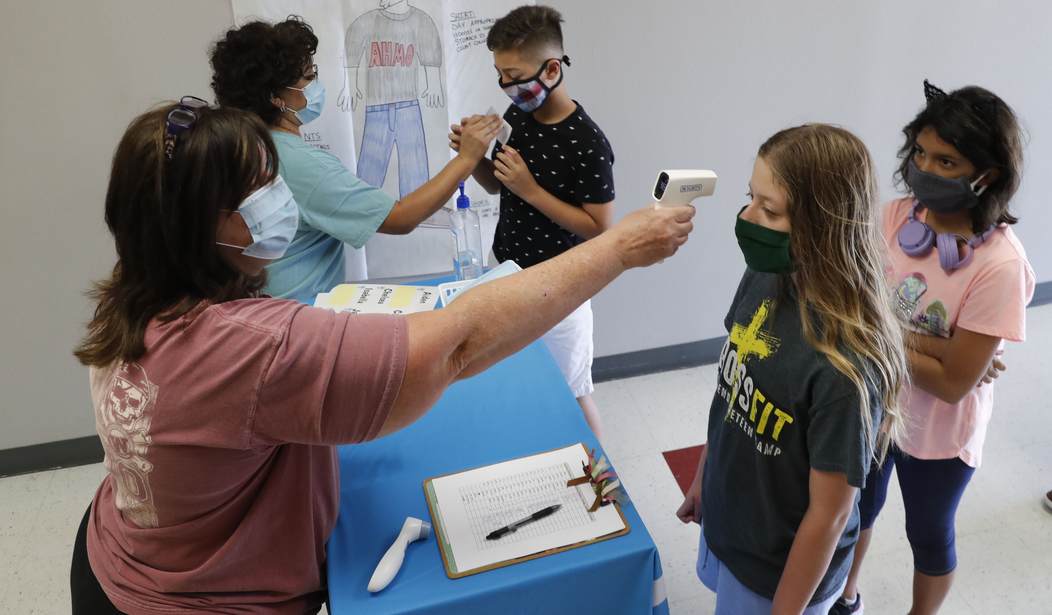It is indisputable that COVID-19 has changed our lives. Some of us are luckier than others and have governors who aren’t overreacting, but the mental health, economic, and social impacts have been well reported. However, emerging research shows that despite the death toll, the mitigation efforts may have been an overreaction. Further, the constant panic porn demonstrated by the media may be a massive overstatement of the problem. The Democrat PR wing of the media reports all positive tests as “cases.” This is deeply misleading.
First, a person who never develops symptoms is not a “case.” We are routinely testing people without symptoms and anyone with a low-grade fever due to employer and institutional policy. The CDC has published guidance that discourages retesting, acknowledging that a fully recovered patient can test positive for up to 90 days.
Said another way, the PCR test can pick up dead virus incapable of causing infection:
Reinfection with SARS-CoV-2 has not yet been definitively confirmed in any recovered persons to date. If, and if so when, persons can be reinfected with SARS-CoV-2 remains unknown and is a subject of investigation. Persons infected with related endemic human betacoronavirus appear to become susceptible again at around 90 days after onset of infection. Thus, for persons recovered from SARS-CoV-2 infection, a positive PCR during the 90 days after illness onset more likely represents persistent shedding of viral RNA than reinfection.
So, employers requiring COVID-19 retesting following recovery from the virus are increasing the number of positive tests that are absolutely not cases. Additionally, research regarding T cell immunity means those who experience a normal immune response to the virus may also test positive and not be infectious.
The New York Times Does Accidental Journalism on COVID-19 Testing
Second, as The New York Times reported and additional research supports, our current testing is too sensitive. A PCR test has what is called a “cycle threshold.” The higher the number of cycles, the smaller the amount of virus RNA in the sample that can result in a positive test result. COVID-19 tests in the United States are currently running a higher number of cycles than other countries, meaning they pick up a much smaller amount of virus. As experts told The Times
Any test with a cycle threshold above 35 is too sensitive, agreed Juliet Morrison, a virologist at the University of California, Riverside. “I’m shocked that people would think that 40 could represent a positive,” she said.
A more reasonable cutoff would be 30 to 35, she added. Dr. Mina said he would set the figure at 30, or even less. Those changes would mean the amount of genetic material in a patient’s sample would have to be 100-fold to 1,000-fold that of the current standard for the test to return a positive result — at least, one worth acting on.
Yet our labs are running 37 to 40 cycles.
One solution would be to adjust the cycle threshold used now to decide that a patient is infected. Most tests set the limit at 40, a few at 37. This means that you are positive for the coronavirus if the test process required up to 40 cycles, or 37, to detect the virus.
Tests with thresholds so high may detect not just live virus but also genetic fragments, leftovers from infection that pose no particular risk — akin to finding a hair in a room long after a person has left, Dr. Mina said
The data shared in the article from three states showed up to 90% of positive tests contained COVID-19 virus RNA either incapable of replicating or in insufficient levels to be transmitted. That means rather than the 6.71 million “cases” reported in the United States today, and we could actually be as low as 671,000.
Barr: COVID-19 Lockdowns Are ‘Greatest Intrusion on Civil Liberties in American History’ Besides Slavery
By way of comparison, Taiwan, whose virus response has been praised by health experts, uses a much lower cycle threshold:
Taiwan has since examined additional data from her test sample, which had a cycle threshold, or CT value of 37-38 — a result on the diagnostic threshold which is often referred to as a “weak positive,” CECC spokesman Chuang Jen-hsiang (莊人祥) said at a press conference.
Only samples with a CT value under 35 are considered positive in Taiwan, while those over 32 are unlikely to be contagious, Chuang said.
Taiwan has reported 503 cases and likely managed their response better because they more accurately identified individuals likely to become ill and transmit the disease to others. How much time and energy are being wasted in contact tracing and testing in the United States when staff chase positive tests that are not going to result in illness or transmission? How many days of school and work are being missed based on this? How many businesses have failed based on oversensitive testing and panic porn based on a number of “cases” that are entirely overblown?
The CDC knows this. So why have they not set a cycle threshold standard? Why are we continuing to use tests going through more cycles than needed? We should all be demanding an answer to this question since the CDC has now changed its guidance again. Due to what appears to be political pressure, it is now recommending widespread testing of asymptomatic individuals which will pick up virus fragments and low levels of the virus incapable of transmission as demonstrated by The Times article:
Clarifications made on September 18, 2020
Due to the significance of asymptomatic and pre-symptomatic transmission, this guidance further reinforces the need to test asymptomatic persons, including close contacts of a person with documented SARS-CoV-2 infection.
You should expect every curve that has been trending downward to show a bump unless the cycle threshold issue is fixed immediately, and we come in line with what other countries, like Taiwan, are using. However, high numbers are exactly what the media and the Democrats want. This CDC guidance on testing is also wholly inconsistent with its guidance on retesting.
Second, T cell immunity is a big deal. T cells are long-term immunity that is maintained by people coming in contact with pathogens like viruses in their daily lives. Every day, a healthy immune system is reacting to the environment to maintain optimal function. T cells reactive to COVID-19 in blood samples have demonstrated that the reaction is based on exposure to other coronaviruses like to ones that cause the common cold.
Lockdowns, masking, and social distancing prevent exposure to these milder viruses that keep a healthy immune system working correctly. Research with SARS hints this may be a real problem in the fight against COVID-19. In a study of mice, researchers found priming the animals with a nasal dose of a less virulent coronavirus also protected the lungs from SARS:
As a result, nasal priming by MHV-1 dramatically reduced the mortality and morbidity resulting from subsequent lethal infection by both SARS-CoV and IAV. A major physiological role of the human nose is to protect the lungs. Our results reveal that in addition to warming, humidifying and filtering inspired air, immunological priming is another lung-protective mechanism initiated in the nose and upper airway.
They summarized:
In summary, we demonstrate that nasal exposure to coronavirus remotely primes lung immunity in the absence of direct lung infection, and that such priming provides effective protection against subsequent lethal viral infection in the lungs. Our data reveal that early exposure to pathogens in the nose and upper airways can immunologically prepare the lungs for more rapid initiation of innate and adaptive immune response against homologous [similar] and heterologous [not similar] infection.
These researchers were talking about nasal priming as a treatment for various types of pneumonia. However, the same thing happens during interaction with the environment all the time. Decreasing these interactions will reduce the effectiveness of the immune response over time. This phenomenon was explained in detail by Dr. Dan Erickson earlier this summer.
As Dr. James Todaro pointed out, in the study, all of the mice whose nasal passages were primed with a virus lived. All of the unprimed mice died. That is a stunning result. All of the extended mitigation may make younger, healthy people more susceptible to COVID-19 because we are coming into contact with fewer pathogens in the course of daily life. We should be insisting this be taken into account by the public health community and have an open debate about the pros and cons.
Our public health experts owe us these answers. Indeed, accurate testing is an essential requirement to manage public policy effectively. If the establishment doesn’t want us to believe the warning from Marc Caputo, maybe they need to address these issues now.
Not after the election. Now.










Join the conversation as a VIP Member